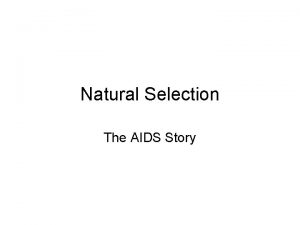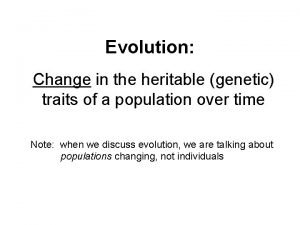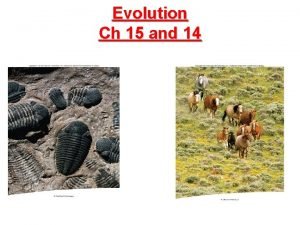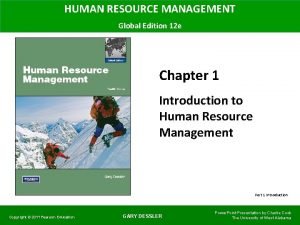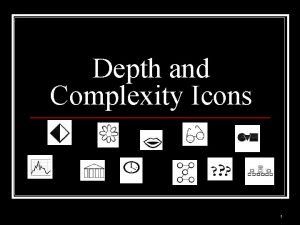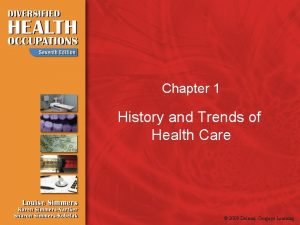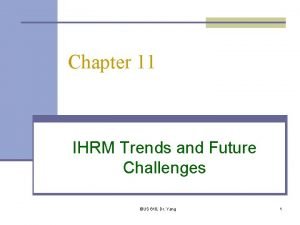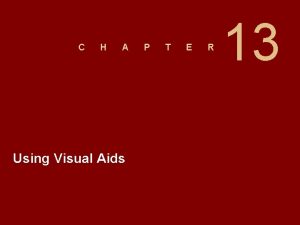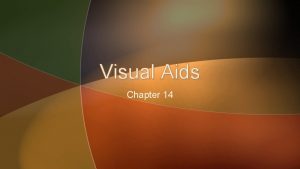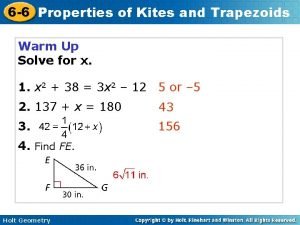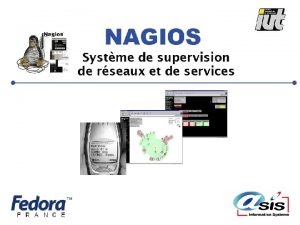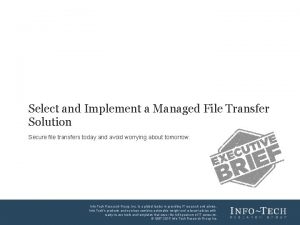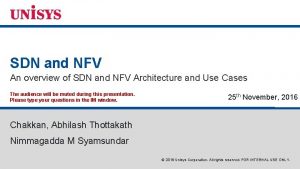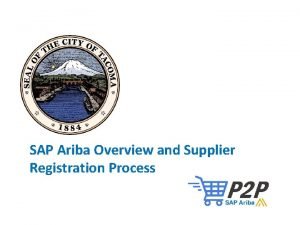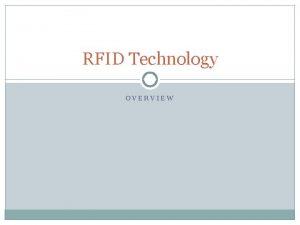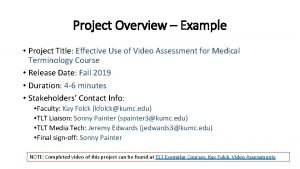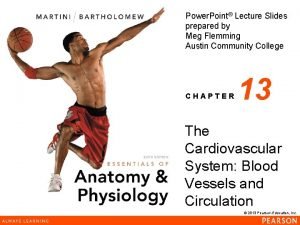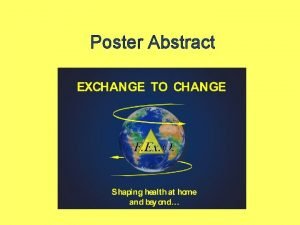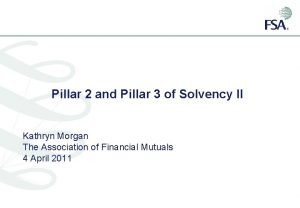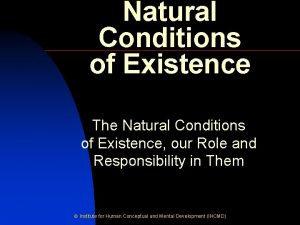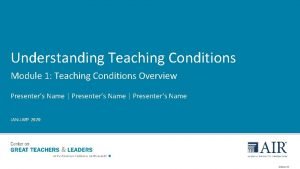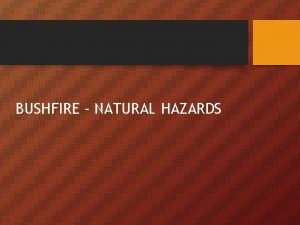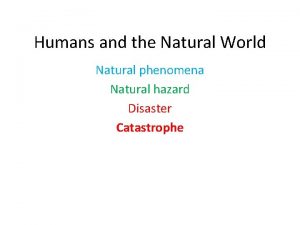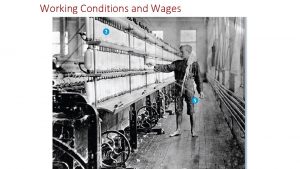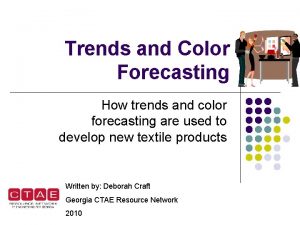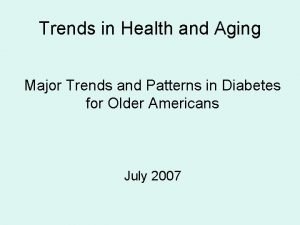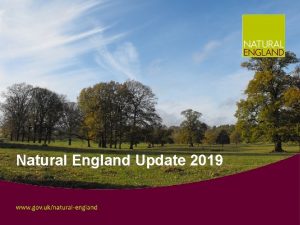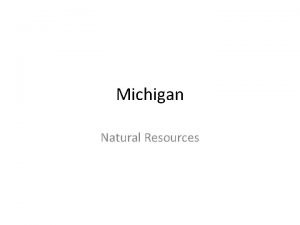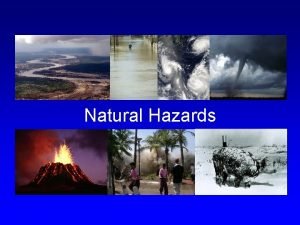Natural Conditions and Trends Overview of Natural Conditions





























































- Slides: 61

Natural Conditions and Trends Overview of Natural Conditions evaluation work 08/27/2019 1

Outline (part 1) • Metric Topics • • Metric run-through Alternate Trijonis values (natural conditions) Future wildfire scenarios Overview for next steps • Data Topics • Threshold adjustment • Overview for next steps • Part 2: Species-specific data trends 2

Metric Topics Metric run-through Alternate Trijonis values Future episodic scenarios 3

Metric run-through Haze Natural Anthropogenic Episodic Routine 4

Natural – Episodic wildfire Episodic dust organic carbon elemental carbon coarse mass soil 5

Natural – Episodic • Using 2000 -2014 data • (per initial draft guidance, https: //www. epa. gov/sites/production/files/201607/documents/draft_regional_haze_guidance_july_2016. pdf) • Find the 95%-ile breakpoint for each year: • of the wildfire (elemental + organic carbon) • of the dust (coarse mass + soil) • Determine the minimum of those years (“low wildfire” and “low dust storm” years) • Selects the year with the lowest wildfire contribution, allowing for concentration to be on lower end of elevated episodic concentrations 6

Natural – Episodic (e. g. GLAC 1, wildfire) minimum for episodic wildfire 7

• AGTI 1: Agua Tibia, urban area southern California • GLAC 1: Glacier National Park, remote near northern border • SAWT 1: Sawtooth, remote, Idaho mountains • SEQU 1: Sequoia, near central valley of California, somewhat urbanized on one side • Carbon threshold vs. site for the given 95%-ile • Carbon threshold vs. threshold, for a given site 8

Natural – Routine Trijonis NCII Naturalroutine Trijonis, J. C. Characterization of Natural Background Aerosol Concentrations, Appendix A in Acidic Deposition: State of the Science and Technology, Report 24, Visibility Existing and Historical Condition – Causes and Effects, National Acid Precipitation Assessment Program, 1990. S. A. Copeland, M. Pitchford, and R. Ames, Regional Haze Rule Natural Level Estimates Using the Revised IMPROVE Aerosol Reconstructed Light Extinction Algorithm, 2008. http: //vista. cira. colostate. edu/improve/Publications/Gray. Lit/032_Natural. Cond. IIpaper/Copeland_et al_Natural. Conditions. II_Description. pdf Draft Guidance on Progress Tracking Metrics, Long-term Strategies, Reasonable Progress Goals and Other Requirements for Regional Haze State Implementation Plans for the Second Implementation Period, 2016. https: //www. epa. gov/sites/production/files/201607/documents/draft_regional_haze_guidance_july_2016. pdf 9

Natural – Routine • Trijonis values • Estimate of “natural” concentrations for east and west • Based on 1990 report, using visibility data and concentrations measured in the 1970 s and 1980 s Ammonium • Values are estimates of “means” (not constants) Sulfate 0. 115 µg/m 3 Ammonium • For the West, the mass concentrations sum to 4. 3 µg/m Nitrate 0. 1 µg/m • ARS report, 2013 (https: //www. wrapair 2. org/pdf/WRAP_Natural. Conditions. Review_20130625. pdf) Organic Carbon Elemental Carbon Soil Coarse Mass 3 3 0. 5994 µg/m 3 0. 02 µg/m 3 0. 5 µg/m 3 3 µg/m 3 10

Natural – Routine • NCII • Actual concentrations, 2000 -2004 data • Re-scale each species so that the yearly averages are equal to the Trijonis value (if the average is already less, it is not re-scaled, scaling factor = 1) • Then, run the re-scaled masses through the new IMPROVE algorithm and find the averages over 2000 -2004… those are NCII • Each site and species has it’s own NCII value, in extinction units (Mm-1) • EPA discusses natural-routine and alternative approaches in their TSD to the guidance (https: //www. epa. gov/sites/production/files/2016 -07/documents/technical_support_document_for_draft_guidance_on_regional_haze. pdf) 11

Natural – Routine • 6 species NCII extinction values + Sea Salt extinction + Rayleigh extinction 12

Trijonis NCII Threshold Naturalroutine Naturalepisodic Anthropogenic Haze 13

Anthropogenic • 14

2064 Endpoint • “we averaged the daily natural (the sum of “episodic” and “routine”) light extinction estimates on the 20 percent most impaired days in each year from 2000 to 2014 to determine new estimates of natural visibility conditions. ” • Only the natural (no anthropogenic) portions of the most impaired days from 2000 -2014 => natural visibility 15

Metric Topics Metric run-through Alternate Trijonis values Future episodic scenarios 16

Alternate Trijonis values (natural conditions) • Tried a “clearest days as natural” assumption • Used the mean of each species on the clearest days (2000 -2017) to suggest alternate Trijonis inputs • (also considered the lowest 20%-ile of each species as “natural”) • Calculate the NCII numbers as is currently done • This establishes new “natural-routine” portions, and also affects the endpoint 17

Trijonis # Ammonium Sulfate (µg/m 3)

Trijonis Values (in 2064 endpoints (in deciviews) ug/m 3) sitecode ep_dv_epa ep_dv_clearest_diff as_0. 115 an_0. 1 om_0. 5994 ec_0. 02 soil_0. 5 cm_3 AGTI 1 7. 63 10. 86 3. 23 0. 351 0. 196 0. 122 0. 105 -0. 126 0. 702 CANY 1 4. 11 4. 66 0. 54 0. 273 -0. 006 -0. 311 0. 01 -0. 249 -1. 682 CHIR 1 4. 93 6. 13 1. 20 0. 336 -0. 009 -0. 212 0. 03 -0. 181 -1. 061 GLAC 1 6. 90 9. 10 2. 20 0. 193 -0. 021 0. 28 0. 098 -0. 351 -1. 863 GRBA 1 4. 30 3. 52 -0. 78 0. 102 -0. 055 -0. 233 0. 015 -0. 353 -2. 201 GUMO 1 4. 83 7. 98 3. 15 0. 478 0. 073 -0. 102 0. 042 0. 022 0. 163 HAVO 1 5. 64 7. 13 1. 49 0. 157 -0. 064 -0. 461 -0. 01 -0. 462 -2. 234 JOSH 1 6. 09 7. 37 1. 27 0. 244 0. 078 -0. 153 0. 041 -0. 15 -0. 542 KALM 1 7. 80 8. 14 0. 35 0. 051 -0. 068 0. 287 0. 052 -0. 46 -2. 126 MELA 1 5. 95 8. 99 3. 03 0. 398 0. 065 -0. 077 0. 031 -0. 18 -0. 16 MEVE 1 4. 20 4. 73 0. 53 0. 217 -0. 007 -0. 22 0. 019 -0. 224 -2. 051 REDW 1 8. 54 8. 80 0. 26 0. 103 -0. 044 -0. 189 0. 012 -0. 46 -1. 571 ROMO 1 4. 93 3. 88 -1. 05 0. 117 -0. 051 -0. 339 0. 004 -0. 364 -2. 068 SACR 1 5. 50 9. 91 4. 41 0. 562 0. 202 0. 076 0. 063 0. 099 2. 067 SAGO 1 6. 19 6. 43 0. 24 0. 15 0. 059 -0. 227 0. 035 -0. 295 -1. 48 SAWE 1 5. 21 9. 43 4. 22 0. 645 0. 169 0. 18 0. 108 0. 687 2. 189 SAWT 1 4. 67 4. 91 0. 24 0. 056 -0. 067 0. 077 0. 022 -0. 382 -2. 524 SIME 1 8. 49 9. 82 1. 33 0. 226 -0. 058 -0. 432 0. 027 -0. 469 -1. 147 STAR 1 6. 59 5. 71 -0. 88 0. 085 -0. 045 -0. 246 0. 009 -0. 405 -2. 375 THRO 1 5. 93 8. 70 2. 77 0. 351 0. 04 -0. 045 0. 057 -0. 196 0. 112 TUXE 1 6. 96 6. 29 -0. 67 0. 034 -0. 07 -0. 492 -0. 009 -0. 467 -2. 359 WHPE 1 3. 53 2. 42 -1. 11 0. 09 -0. 052 -0. 386 0. 009 -0. 373 -2. 285 WHRI 1 3. 02 1. 73 -1. 29 0. 062 -0. 055 -0. 476 0. 01 -0. 398 -2. 612 YELL 2 3. 98 3. 48 -0. 50 0. 098 -0. 019 -0. 313 0. 002 -0. 425 -2. 618 YOSE 1 6. 29 4. 60 -1. 69 0. 065 -0. 045 -0. 27 0. 008 -0. 407 -2. 227 • Colored cells represent difference amounts EPA value is less EPA value is greater • Left side of the table: • Endpoints using EPA assumptions and “clearest as natural” assumptions • Right side of the table • Headings represent Trijonis values • Cell values represent the difference between the Trijonis value and the “clearest as natural value” • (Trijonis minus “can”) 19

Alternate Trijonis numbers • What the “clearest days as natural” assumption suggests: • Ammonium sulfate and elemental carbon Trijonis values too low • Coarse Mass and Soil Trijonis values too high • Ammonium nitrate and organic mass are more site-dependent (could not generalize) • Question: • Are clearest days the best representation of natural-routine? 20

21

Observations • “Clearest” days are getting “clearer” • The clearest days concentrations are trending downward, so they may not serve as a good natural conditions estimate • Are natural conditions changing? 22

Metric Topics Metric run-through Alternate Trijonis values Future episodic scenarios 23

Future wildfire scenarios • Questioned: how does metric treat elevated carbon impacts in those future scenarios, simulating a high wildfire year (while other species kept their progress towards natural)? • In the scenario shown in the following slides, we simulated a uniform reduction of all species, while holding episodic carbon species constant, to see how the glidepath and MIDs looked 24

Future wildfire scenarios • GLAC 1: assume constant rate of decrease of every species, to their NCII values in 2064 • EXCEPT for any episodic carbon, as determined by the metric in 2017 • Hold the portion of the carbon concentration allocated episodic as constant, reduce all other species uniformly to their NCII values • Some of the carbon will get reassigned from year to year as the other non-episodic carbon gets reduced, but the raw amount determined from 2017 is constant • In order to simulate elevated future episodic carbon (during fire season), while allowing all other species to gradually improve 25

26

Notes • As time goes on, more of the most impaired days start to get assigned to the days with episodic carbon (that raw carbon concentration is held constant) 27

many episodic days are most impaired Flatter progress 28

Wildfire scenarios conclusions • Assuming every future year is a bad wildfire year is probably crude, but it still can be illustrative for showing isolated high wildfire years in the future • Improvements can be made going toward 2064 goals, but the metric may not adequately handle episodic days in the future • The metric assigns anthropogenic to any day with episodic contributions • Although this is handled adequately in years with elevated concentrations that are not episodic (because of the ranking based on deciview instead of on light extinction), in future years where the non-episodic concentrations are expected to lower, the anthropogenic contribution on episodic days becomes significant 29

Overview for next steps • Natural-routine analysis • Natural conditions may not be constant • Seasonal values • Have natural-routine account for seasonal variations • Regional values (instead of just East and West) • Can current modeling, emissions inventories, and monitoring data combined help better estimate natural? • Zero out anthropogenic emissions scenarios (call the rest natural)? • Can work of Schichtel, et. al. be expanded on with new modeling results? (Schichtel, B. A, Rodriguez, M. A. , Barna, M. G. , Gebhart, K. A. , Pitchford, M. L. , Malm, W. C. A semi-empirical, receptor-oriented Lagrangian model for simulating fine particulate carbon at rural sites. Atmos. Environ. , 61, 361 - 370, 2012. ) See EPA’s TSD for evaluation, concluded that modifications do not significantly alter deciview trends… will this become important as anthropogenic contributions decrease? • Future wildfire scenarios • Consider revising metric to account for future high episodic contributions • Anthropogenic assignment on wildfire days become significant as concentrations reduce on non-episodic days • As suggested in EPA’s TSD, consider all contributions as natural on episodic days in future planning periods? 30

Data Topics Threshold Adjustment Part 2: Species-specific data trends 31

Threshold adjustment: Case Study Comparison Agua Tibia Wilderness (AGTI 1) • Southern California • Monitor elevation ~500 meters within coastal marine inversion, 50 km from ocean • 5, 934 acres • Inside Cleveland National Forest at southern crest of mountains ringing Los Angeles Basin at northern edge of San Diego County • Wilderness characterized by chaparral, fir, pine, and oak on mountains in hot dry climate with no permanent streams • Between Los Angeles (pop. 18 million) Extreme ozone and Moderate PM 2. 5 and San Diego (pop. 3 million) Moderate ozone non-attainment areas Sawtooth Wilderness (SAWT 1) • Central Idaho • Monitor elevation ~1900 meters in valley subject to smoke-trapping inversions • 217, 088 acres • Western wilderness portion of Sawtooth National Recreation Area characterized by granite peaks, high alpine lakes, multiple streams, narrow glacial valleys with enormous stands of trees • Remote from major source regions • Boise (population 227, 000) 180 km south of Sawtooth separated by mountain range • Over 300 km to nearest non-attainment area 32

Species concentrations by month 33

Species concentrations by month • Shows the species averages by month on MIDs, 2000 -2017 • Width of each bar is proportional to the number of MIDs in that month • Plots show both the magnitude differences and the seasonal differences in the two sites • AGTI 1 has a significant nitrate and sulfate contribution, MIDs tend to be early summer months • SAWT 1 has very little nitrate, and fairly constant organic carbon contribution, MIDs tend to be summer/fall months • Sulfate patterns are opposite at these sites 34

Threshold adjustment • Put the data through EPA’s metric • Varied the percentile threshold for episodic • 60→ 100%-ile in 1 %-ile increments • Looked at how the anthropogenic and natural split depended on the threshold • Especially the carbon (episodic wildfire) species • Looked at two sites that show much different behavior • AGTI 1 • SAWT 1 35

Glidepaths 36

Glidepaths • Shows the different glidepaths for select thresholds • Notable: • Magnitude differences in baseline and endpoint deciviews • The sensitivity differences to varying thresholds • In progress lines and their characteristics • AGTI 1 maintains same shape • SAWT 1 progress is more dependent on threshold • In endpoints • AGTI 1 endpoints spread over a couple deciviews • SAWT 1 endpoints less affected by threshold (except for the 100% threshold case) 37

38

Sample year - 2011 • Graph shows most impaired days at both sites for 2011 • Notice magnitude and species contributions • Shows the seasons when the MIDs • How the anthropogenic/natural breakdown looks • AGTI 1 shows larger anthropogenic components • SAWT 1’s anthro is much lower, more comparable to natural-routine • SAWT 1 data may be “buried” in the noise of natural-routine, more sensitive to appropriate NCII values 39

Carbon vs. threshold (MIDs) 40

Carbon vs. threshold (MIDs) • Look at the anthropogenic-natural split in carbon contributions on MIDs • Sites show different behavior in the natural portion • AGTI 1, shows natural generally decreasing with increasing threshold (more carbon gets allotted away from episodic and towards anthropogenic) • SAWT 1, shows natural generally increasing with increasing threshold (something different is going on… episodic should be decreasing, but something else is causing the increase) • See circled portion of SAWT 1, 2011, where the plot starts to increase 41

All species vs. threshold (MIDs) 42

All species vs. threshold (MIDs) • Look at the anthropogenic-natural split at all species • Both sites show similar trends in anthropogenic • Natural shows different behavior, especially after about 80 -90%-ile – looks to be dominated by carbon 43

Carbon assignments by year (MIDs) 44

Carbon assignments by year (MIDs) • A look the carbon assignment, by year and threshold • Anthropogenic • Natural • Ratio of anthropogenic to natural • Sites show generally similar trends, but SAWT 1 is much more erratic • Especially in the natural allotment • Amplifies the sensitivity of the natural assignment to threshold adjustments 45

(Carbon+Dust)/(Nitrate+Sulfate) ratios (MIDs) 46

(Carbon+Dust)/(Nitrate+Sulfate) ratios (MIDs) • Looked at ratio for all species types (anthro/natural), and by anthropogenic and natural separately • The idea was that if the “right” threshold was chosen, the anthropogenic ratios would show more “normal” behavior • Like the carbon-only breakdowns, these plots show the “stability” of AGTI 1 with respect to threshold (notice y-axis scales) • On the contrary, these plots amplify the sensitivity of SAWT 1 to threshold 47

How 2064 Endpoint changes with threshold 48

How 2064 Endpoint changes with threshold • Sites show different behavior • AGTI 1, endpoint gradually reduces with increasing threshold • SAWT 1, endpoint reduces, then turns around at around 80% • Species specific contributions highlight which species contribute to the deciview endpoint trends 49

2064 Endpoint vs. threshold, natural split 50

2064 Endpoint vs. threshold, natural split • Sites show different behavior in the natural-routine and naturalepisodic split • AGTI 1, episodic gradually decreases, routine fairly constant, overall dominated by episodic contribution • SAWT 1, shows similar behavior at first, then episodic and routine grow considerably somewhere between 80 -90%-ile 51

Routine and episodic vs. threshold 52

Routine and episodic vs. threshold • Illuminates what was shown on the previous slide • Notice the y-axis differences between the 2 sites, especially on the natural-routine slide • AGTI 1 natural-routine shows very gradual increase • SAWT 1 natural-routine starts out gradual, then climbs much quicker somewhere between 80 -90%-ile 53

Routine and episodic carbon vs. threshold 54

Routine and episodic carbon vs. threshold • Looked at carbon, due to it’s role in episodic contributions • Illustrates similar points as previous slides 55

Sample year - 2011 56

57

Sample year - 2011 • SAWT 1 • Animation shows how the MID’s shift to the summer wildfire-likely impacts • This increases the natural-routine contribution as indicated on the previous slide 58

Case study conclusion • For SAWT 1, • assigned anthropogenic levels more comparable to the natural-routine portions • MIDs are more sensitive to threshold adjustment • As threshold increases, more of the MIDs occur during wildfire-likely impacts • Those elevated carbon MIDs increase natural-routine portion, which causes the sudden change in behavior 59

Overview for next steps • Refine natural conditions estimates (perhaps site/region-specific and season-specific) to avoid possible artifacts in the data, hopefully current modeling simulations will be useful tools (see slide 30) • As levels approach natural conditions, this becomes more important • In future metric improvements, allow for episodic impacts to occur while not necessarily introducing anthropogenic • States: • Evaluate if the metric adequately accounts for episodic impacts at their sites • Look at yearly data, archived satellite data to confirm • Look at how natural-routine changes with threshold for indicators of MID sensitivity 60

Contact Brandon Mc. Guire, bmcguire@mt. gov, 406 -444 -6257 Tom Moore, tmoore@westar. org Coordination and Glide Path Subcommittee, http: //wrapair 2. org/RHP_coordination. aspx 61
 Aids basketball player
Aids basketball player Natural selection conditions
Natural selection conditions Criteria for natural selection
Criteria for natural selection Current trends in media and information
Current trends in media and information Natural capital and natural income
Natural capital and natural income Perbedaan replikasi virus dna dan rna
Perbedaan replikasi virus dna dan rna Data cleaning problems and current approaches
Data cleaning problems and current approaches Carbon family
Carbon family An overview of data warehousing and olap technology
An overview of data warehousing and olap technology What is bioinformatics an introduction and overview
What is bioinformatics an introduction and overview An overview of data warehousing and olap technology
An overview of data warehousing and olap technology Data quality and data cleaning an overview
Data quality and data cleaning an overview Data quality and data cleaning an overview
Data quality and data cleaning an overview Overview of storage and indexing
Overview of storage and indexing Chapter 17 overview elements and their properties
Chapter 17 overview elements and their properties Trends and issues in nursing
Trends and issues in nursing Section 1 guided reading and review labor market trends
Section 1 guided reading and review labor market trends Trends and issues in nursing
Trends and issues in nursing Demographic trends affecting human resource management
Demographic trends affecting human resource management Describing trends in a graph
Describing trends in a graph Complexity icon
Complexity icon Ihrm trends
Ihrm trends Chapter 1 history and trends of healthcare
Chapter 1 history and trends of healthcare Gis evolution and future trends
Gis evolution and future trends Modelling relationships and trends in data
Modelling relationships and trends in data Future of ihrm
Future of ihrm Chapter 1 history and trends of healthcare
Chapter 1 history and trends of healthcare A visual aid used to show statistical trends and patterns
A visual aid used to show statistical trends and patterns A visual aid used to show statistical trends and patterns
A visual aid used to show statistical trends and patterns Manage personal and professional development
Manage personal and professional development New trends in recruitment and selection
New trends in recruitment and selection Observing trends in entrepreneurship
Observing trends in entrepreneurship Market size sample
Market size sample Global oncology trends 2017 advances complexity and cost
Global oncology trends 2017 advances complexity and cost Natural hazards vs natural disasters
Natural hazards vs natural disasters Properties of kites
Properties of kites Www stands for world wide web
Www stands for world wide web Maximo work order priority
Maximo work order priority Uml overview
Uml overview Uml
Uml Vertical retailers
Vertical retailers Figure 12-1 provides an overview of the lymphatic vessels
Figure 12-1 provides an overview of the lymphatic vessels Lung blood supply
Lung blood supply Texas public school finance overview
Texas public school finance overview Walmart company profile
Walmart company profile Stylistic overview
Stylistic overview What is sa/sd methodology?
What is sa/sd methodology? Spring framework overview
Spring framework overview Nagios tactical overview
Nagios tactical overview Market overview managed file transfer solutions
Market overview managed file transfer solutions Nfv vs sdn
Nfv vs sdn Sbic program overview
Sbic program overview Sap mm consignment process
Sap mm consignment process Ariba overview
Ariba overview Safe overview
Safe overview Rfid technology overview
Rfid technology overview Sots meaning in research
Sots meaning in research Example of a project overview
Example of a project overview Blood supply of stomach flowchart
Blood supply of stomach flowchart Abstract vs summary
Abstract vs summary Solvency 2 pillar 3
Solvency 2 pillar 3 Types of physical storage media
Types of physical storage media
